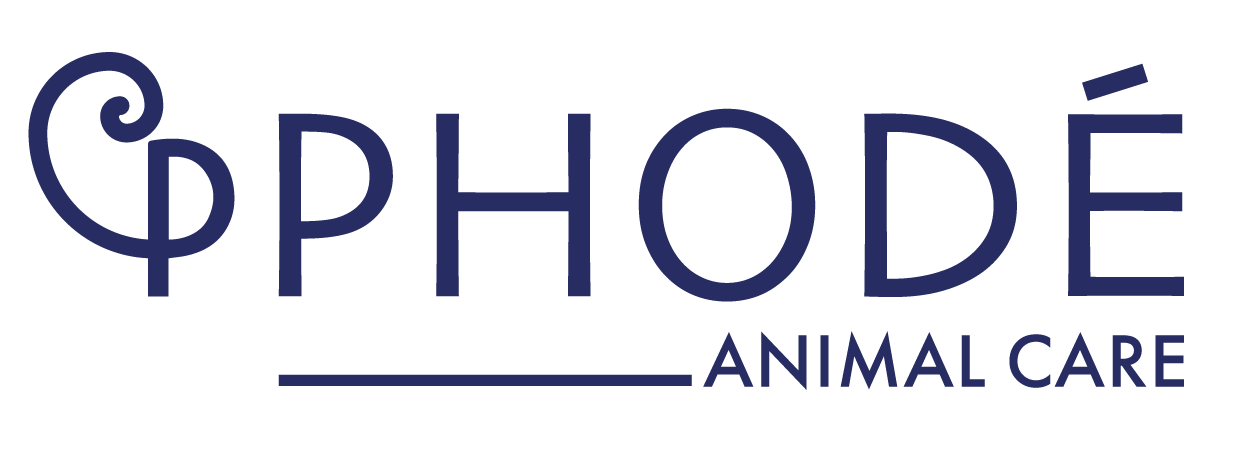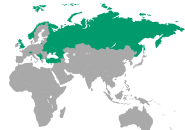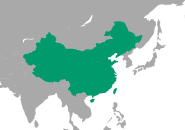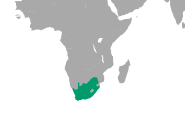The installation and management of a milking robot is not without consequences on the management of the farm and the behaviour of the cows. The novelty and stress of the milking robot often causes problems with attendance or access, especially with primiparous cows.
An optimal and well thought architecture can limit problems of access to the robot, of fluidity… It is also judicious to help the animal to better manage the stressful situation, for better performance as well as more well-being. A plant extract based on citrusinensis essential oil, by its mode of action, allows to manage the negative impacts on the behaviour of cows linked to a stressful situation, such as the milking robot.
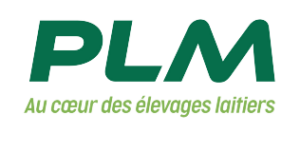
The article published in the French magazine PLM (No. 544, September-October) and translated and reproduced below, with their kind permission, explains in detail the impact of the milking robot on cow behaviour and performance.

Expertise
With Marion Fourmont,
FDS consultant (Farm Dairy Service)
You are planning to install one or more milking robots? You have already talked to your dealer, your banker, your vet, your chiropodist… But don’t forget to think about it, to imagine, to visualise. The essential question concerns the handling and restraint of the animals. “How will you be able to isolate and block one or more cows easily?”
1 – Think about yourself first: how will your interventions be as easy as possible?
Acting quickly is the key. What do I plan to do in case of:
– insemination,
– trimming,
– care,
– late cows,
– a quality alert,
– a cow to dry off,
– a freshly calved cow…
Think about everything. “And in all circumstances,” insists Marion Fourmont, FDS consultant. It’s true that during the week, sometimes everything is simple. Routine. “But beware of weekends. Will an employee, a replacement or a less experienced partner be able to manage as well as you?” Or will you be able to bring in the cow that has just calved, without having to take her across the farmyard?
At the same time, you will think about the type of circulation, “free, feed-first, milk-first, optimised free…» Visiting other installations will help you to see clearly, to find ideas, examples and experiences.
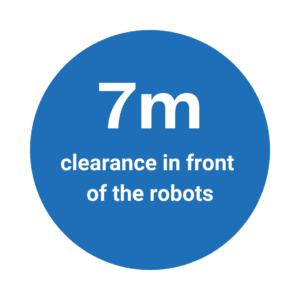
To avoid congestion, give confidence to the dominated. And even 8m depending on the configuration.
Here are three examples of sorting areas
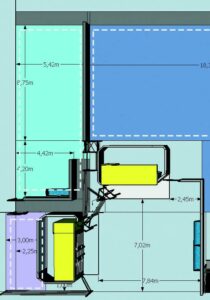
Zone A. From here, the cows do not have an independent return to the robot. This area can be used to isolate very fragile cows or those undergoing treatment.
Zone B. They can return to one of the robots. This area can accommodate freshly calved cows or cows that tend not to visit the robot very often. T they will not be subjected to competition.
Zone C. No independent return to the robot. This area is used as a temporary holding pen, for example, for cows to be trimmed or inseminated. The animals are sorted automatically. The farmer does not intervene in front of the robots. He does not interfere with the traffic.
2 – Think about the dominated: how do you encourage them to use the robot?
The cow’s autonomy, its self-confidence and its ability to dare to come to the robot are all conditions for success. In order for the cow to be confident, “the space in front of the robots must be as large as possible”:
– 5 m, at least, in front of a single stall;
– 7 m if there are two milking stalls.
We’re talking about real clearance. Without obstacles. Marion Fourmont insists: “No equipment (drinking trough, low stall wall, cow brush, etc.) should eat up the 5 or 7 metres required. The aim is to avoid congestion and face-to-face traffic. The path must be fluid, logical, “without zigzagging or going back and forth”, like a forward march. “The animals should make as many loops as possible and avoid crossing each other. As a reference, “100 dairy cows in a herd, at 2.7 milkings per day and 1 refusal per cow, give 370 passages…”
Cross-corridors
Other strategic areas are the transverse lanes. They must be wide enough to allow the animals to escape, facing a dominant or the scraper. “Be careful, just because the building is on slatted floors, with a robot scraper or a slurry hoover, does not mean that the cross alley should be narrow! If a dominant cow is standing there and blocking the whole passage, the others will not move.
The back corridor
In freestall barns, the back alley can be used for a foot bath, as well as for traffic and watering. A multi-purpose corridor. “But, here too it must be wide enough: a good 5 m. Or, if the objective is not to install a foot bath, 3.5 to 4 metres is the minimum. One solution, highlighted by Marion Fourmont, is to have two single troughs, facing each other, rather than one large trough, to save space. The cows come to drink along the wall, without getting in the way, leaving space for others to pass. “Two cows should be able to pass each other while the others drink. At the feeding table, it’s the same: behind cows that are eating, two others must be able to move around and pass each other.
The sorting area when leaving the robot, a term sometimes misunderstood
When we talk about a sorting area, associated with the robot, the word sorting is sometimes misunderstood. As if the system was not working properly, forcing the animals to be sorted. But this has nothing to do with that. This sorting area is a referral area. As Marion Fourmont explains: “It makes life easier, to divert a cow to the AI or care box; to direct a freshly calved cow to the resting area. Without complication, without wasting time or disturbing the others. “It allows us to have a few animals on hand without disturbing the rest of the herd.
The number of visits depends on the space left in front of the robots
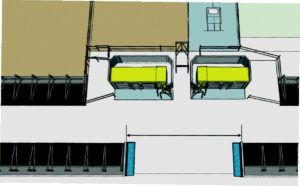
1-Example of a freestall building with two stalls. The robots are centred in the middle of the barn. Cows that need attention are sorted to the rear. There is a wide opening of 8.00 m. This allows the animals to move freely. This allows the cows to move freely towards the robot, but also to get out and drink without obstructing traffic.
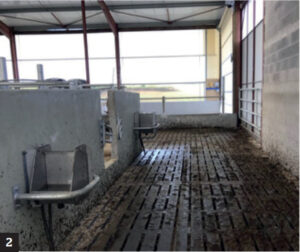
2 – The width of the transverse alleys is also important. Here, in the back alley: 3.50 m seems to be the strict minimum; 5 m will give the possibility to place foot baths.
For the water troughs, two single troughs limit the space requirement. Cows can drink from these troughs along the wall, without standing in the way of the alley and thus without disturbing the others. In total, don’t forget the minimum 10 cm of water access per cow. Always use water troughs that are easy to empty.
3 – Example of a straw-bedded stall with a milking robot at the end and sorting at the rear: 5 m of clearance has been provided, which is a minimum. The first obstacle, the water trough fixed to the wall at mid-height, does not encroach on this 5 m.
4 – Here, the width of the alley provides space for a foot bath.
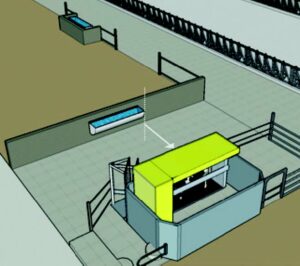
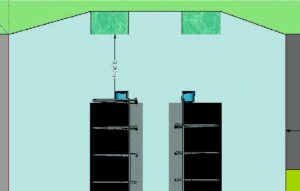
3 – Think of yourself again: with a nice office close to the milking area.
With the robot, you will spend more time in the office. Plan for it to be easily accessible, single level, quiet, comfortable. “24-hour automated milking means there are a number of daily reports to consult. And there’s always information to be entered: AI, gestation records, treatments, etc.”
To be reactive and avoid forgetting things, Marion Fourmont advises having the office near the milking area. “This allows you, for example, to enter treatment data and then administer it quickly. Think of an office that is as pleasant in winter as in summer, bright and welcoming.
And also
For bedding, it changes everything
In a robot, think about it, “you won’t maintain the stalls or the straw bed as you used to”, for the simple reason that all the cows won’t get up at the same time.
And for scraping?
Device, frequency, efficiency… Take time to choose your scraping system. The cleanliness and health of the legs is an even more technical subject in a barn with robots.
On the right track
For the cleanliness and health of the legs, it is best to avoid damp areas in the corridor. Ensure:
- a 1.5% slope, lengthwise,
- 1.5% towards the scraper rail, if one is present.
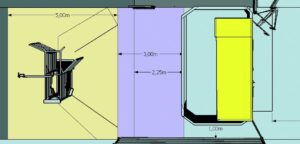
The sorting area gives access, here, to the trimming stall
Extract from PLM
No. 544 September-October 2022
All of the above suggestions can improve the comfort of the cows (and the farmer) and therefore their performance, but they must be implemented. And the milking robot is still a stressful situation, even more so for primiparous cows.
Integrating a solution , dedicated to the animal to enable it to better manage the stressful situation, is an effective way to manage the negative impacts of stress on the animal and therefore its performance.
